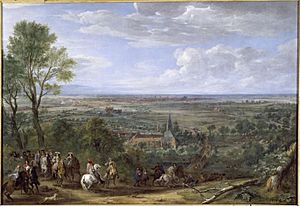Siege of Lille (1667) facts for kids
Quick facts for kids Siege of Lille |
|||||||
|---|---|---|---|---|---|---|---|
| Part of the War of Devolution | |||||||
 Louis XIV at Lille |
|||||||
|
|||||||
| Belligerents | |||||||
| Commanders and leaders | |||||||
| Louis XIV Turenne (army commander) Vauban (siege commander) |
Comte de Bruay | ||||||
| Strength | |||||||
| Unknown | Siege: 4,200 garrison Relief operation: 8,000-12,000 |
||||||
| Casualties and losses | |||||||
| Siege: Unknown Relief operation: Very light |
Siege: Unknown Relief operation: 2,000 killed or wounded 1,500 captured |
||||||
The Siege of Lille happened during the War of Devolution. This war was a conflict between France and Spain. French forces, led by Louis XIV, attacked the city of Lille from August 10 to September 26, 1667. It was the only big battle of the war.
Lille was an important victory for the new siege methods developed by Vauban. Louis XIV claimed that his wife's dowry from Spain had not been paid. Because of this, he decided to expand France's borders. He invaded the Spanish Netherlands, which started the War of Devolution. After capturing other cities like Charleroi, Tournai, and Douai, French troops surrounded Lille. At that time, Lille was part of Flanders and ruled by Spain. Vauban's smart siege techniques were key to the French victory.
Contents
Why Lille Was Attacked
After Lille was captured in 1304 by Philip IV, it remained part of Flanders. However, it had to pay money to France every year. Louis XIV wanted Lille to become a permanent part of France.
In May 1667, Philippe Spinola, who was the governor of the area, told the leaders of Lille to get ready. He said they needed more soldiers and supplies. They also had to fix and improve the city's defenses. The city leaders followed his orders.
The French Advance
French troops began to capture nearby towns. They took Armentieres in May and Bruges in June. The French king and his army then moved towards Hainault. By June 16, they had taken Tours, Douai, and Kurtre. Other towns also surrendered. Louis XIV made a fake attack on Dendermonde to trick the enemy. On August 10, the first French soldiers arrived at Lille and started preparing for the siege.
The Siege Begins
The French began their attack on the eastern side of the city. This was near the Becquerel river and the Thebes gate. King Louis XIV himself was in charge of the siege. On August 11, the French quickly captured a small fort called Lunette, which was in front of the Thebes gate.
Attacks and Defenses
By August 19, the French had finished their preparations. They attacked at the same time from two sides. The King's Guard attacked the Thebes gate. Other French soldiers attacked the Nobltur Bastion. On August 21, the French finished building their cannons. Their powerful fire soon destroyed the Spanish cannons at the Thebes gate.
The Spanish defenders then built new cannons on the St. Maurice and St. Mary Magdalene bastions. A famous Spanish cannon called Meunier caused a lot of damage to the French. During this time, many fires broke out in the city. On August 23, the French built more cannons to fire across the Becquerel river.
Running Out of Supplies
The people inside Lille only had enough gunpowder for about 8 to 10 days. They started ringing the town bell to signal for help from the Spanish general, Count Marzenu. They hoped to see signal lights from nearby hills, meaning help was coming.
The French soldiers openly attacked and captured a part of the outer defenses near the Thebes gate. Over the next two days, the French fired even more cannons. They also took control of the wooden fences that protected the city.
A Surprise Attack
On August 26, the Spanish soldiers tried to break out of the city. Their cavalry attacked the French camp. The next night, while the Spanish were resting, the French Guard launched a quiet surprise attack. They rushed the Thebes gate and captured it. At the same time, other French soldiers captured the Nobltur Ravelin.
The French had many losses, but the situation for Lille was now very bad. The city leaders asked their commander, Bruay, to talk to the French king about surrendering. Bruay gathered his senior officers. They wanted to counter-attack and take back the captured forts. However, Bruay decided against it because his troops were not ready.
Bruay began talks to surrender Lille on August 28. The French king entered the city and promised to protect the city's special rights and rules.
What Happened Next
After the siege, the Treaty of Aachen in 1668 officially made Lille part of France. Louis XIV asked Vauban, the military engineer, to make the city's defenses even stronger. Vauban had been injured during the siege when a bullet hit his cheek. Because of his great work, Vauban was put in charge of many important engineering projects for France.
See also
 In Spanish: Sitio de Lille (1667) para niños
In Spanish: Sitio de Lille (1667) para niños

